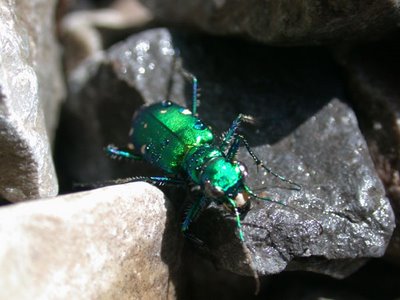
Six-spotted Tiger Beetle (Cicindela sexguttata)
Today I was cleaning out the filter on the pond when I looked down to see one of my favorite insects. I immediately misted it with a hose so that I could take a few photos before it was able to fly off. It was the marvelously colored Six-spotted Tiger Beetle. If anyone is familiar with these critters, they know that they are rapid fliers and the misting technique is one learned after many years of teaching entomology. I have also had several students throughout the years try to catch the beasts in their hands. OUCH! The students soon learned that this beetle has a pair of powerful mandibles that can give a quality pinch.
Tiger Beetles are fairly small, growing about 1/2 inch long. They are easy to identify with their bright metallic green body. The outer wings, called elytra, each have three to five white spots. Since the beetle has two elytra, it could actually have a total of six to ten spots. Legs and antennae are also bright green.
Six-spotted Tiger Beetles can be found in open woods, and along paths and streams.
These beetles usually live alone and only get together to breed. They can be seen from April to August. After mating, the male beetle rides on the back of the female for a while, so it can keep other males from mating with her.
Female beetles lays eggs in June or July. Each female digs holes in the ground and lays one egg in each hole. She uses her ovipositor to lay the egg, then covers up the hole with dirt.
When they hatch, beetle larvae (called "grubs") burrow tunnels down into the soil. To eat, a larvae pops its head out of its tunnel to grab prey. It then pulls the prey down into its burrow.
Tiger beetle larvae eat ants, spiders, and other small prey it can grab. This species has a 2 year lifecycle.
Hope you enjoy my photos of this entomological gem!




0 Comments:
Post a Comment
<< Home